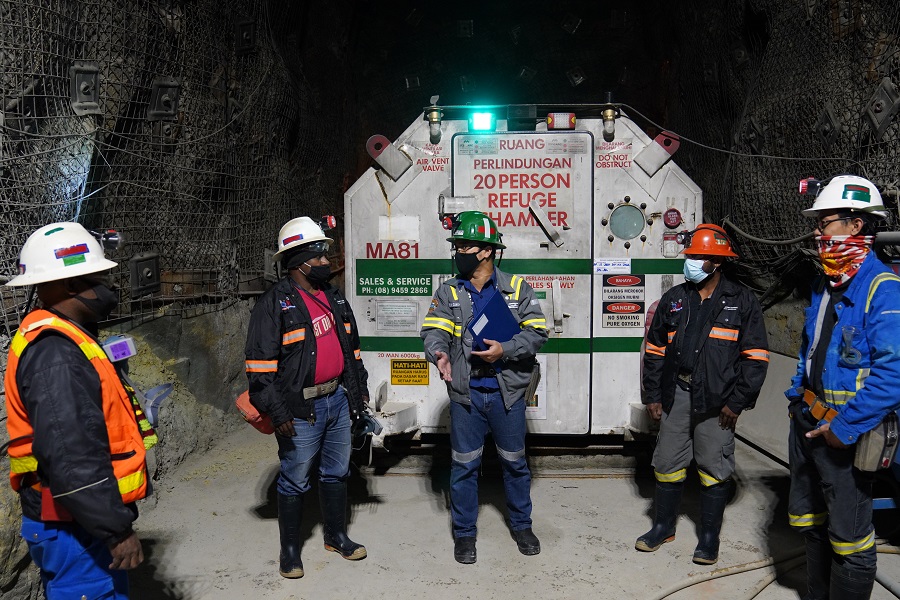Bridging the Signal Gap: Joint Water Rescue Training Unites the Rescue Teams
Far beyond the familiar docks and harbor lights of the PTFI’s Portsite, there lies a remote stretch of coastline where the Ajkwa river pours into the sea. This vast, water-dominated area – thick with mangrove forests and threaded by winding river branches – spans more than 4.691 square kilometers is part of the PTFI operations area, that falls under the coverage of PTFI’s Emergency Preparedness & Response (EP&R) team. At the edge of this point, the territory becomes even more challenging, and only accessible through close coordination with Basarnas, Indonesia’s National Search and Rescue Agency.
In this area, 4,271-square kilometers or about 91% of the area included in PTFI’s operational area, telecommunications signals simply don’t exist. There’s no cell tower coverage, no Wi-Fi, and certainly no quick phone calls when something goes wrong. For the local fishermen and residents who rely on these waters, that silence can be dangerous. Emergency situations – whether it’s a capsized boat, onboard fire, or sudden illness – can escalate quickly without a reliable way to call for help.
To strengthen preparedness in such conditions, PTFI on Tuesday, May 27, 2025 conducted a joint water rescue training exercise in collaboration with the Basarnas team. This wasn’t just a routine drill – it was a hands-on simulation of the very emergencies we may one day have to face in real time. The operation spans the area near the Ajkwa river’s mouth, where the water flows wide and deep, and the mangrove coverage makes visibility and movement difficult.
“This exercise is an important opportunity to share knowledge between EP&R and Basarnas in responding to emergency scenarios designed to closely resemble real-life situations.,” said Periyadi, Manager Fire Safety & Emergency Response, Mining Safety Division. “This strategic collaboration aims to enhance the preparedness of rescue teams in carrying out evacuations during emergencies along the southern coastal area of Mimika.”
For our emergency responders, the physical toll was also real. Hours on boats in unpredictable waters may lead to seasickness for some, adding another layer of difficulty to an already complex operation. But the team pushed through, knowing the importance of this training.
Employees from various departments took part – from Marine Operation, Environmental to Community Affairs, Government Relations, Security Risk Management, and International SOS. Everyone had a role, whether navigating support vessels, communicating to the local community, managing safety equipment, and relaying radio communications, or preparation for medical assistance. The Government Relations team played a vital role in enabling fast communication and coordination with local officials, especially in situations occurring outside of PTFI’s operational boundaries, where joint efforts with Basarnas are required.
“This joint exercise is designed to strengthen coordination and communication between Basarnas and PTFI in conducting search and rescue operations, as part of a shared commitment to assist Mimika Regency communities in need,” said Charles, Head of Operations at Basarnas.
The scenarios were based on actual cases reported in the area: seven local fishermen joined the training, volunteering their boat to help simulate real scenarios such as, a fisherman’s boat catching on fire, a fisherman falling overboard, crew members in need of medical attention, the vessel just drifting in the waters with no captain. With no mobile network to rely on, teams practiced using pre-determined radio channels and smoke signals to relay distress calls and coordinate responses.
As the training wrapped up, and the boats returned to port, the atmosphere was a mix of quiet fatigue and steady pride. The team knew that the challenges of working in remote areas will always be there – rough seas, signal blackouts, long travel times – but so will the preparations, the teamwork, and the commitment to never look away when someone needs help.
For PTFI, this wasn’t just the third joint training conducted. It’s part of an ongoing commitment to safety – not just for our employees, but for the wider community along the operation site. Even in the most isolated stretches of the map, where phone signals fade and the current runs strong, our emergency response team are determined to be ready.
Back To List





.jpg)
.jpg)
.jpg)
.jpg)
.jpg)
.jpg)
.jpg)
.jpg)

